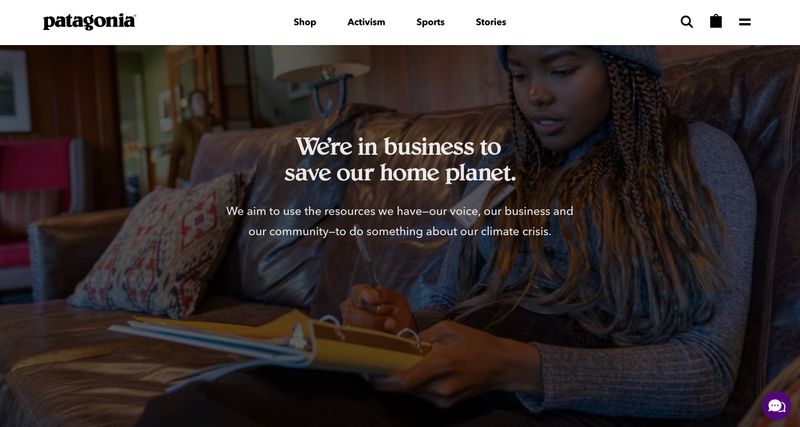
Sustainability has been the largest, most significant growing sector of the past five years. As noble as that sounds, it can be easy to forget it's just like any other industry. It's composed of manufacturing, operations, and marketing departments that fuel the products while trying to appease the customers.
If you are looking to compete in this industry, you need to know how highly intentional and precise your moves need to be because you're being watched more closely than they may think.
In this space, the features that make a company unique boil down to its demographic, its website's intentionality, and the brand's accountability.
Let's break it down:
Less words, more impact
While it's true that,
—Social impact study by Cone Communications
—that doesn’t mean everything needs to unravel right there on the homepage. Without a clear, straightforward strategy in place, you’ll get the opposite result of your intentions. The consumer will end up overwhelmed, confused, and ready to eject.
So what can you do to keep retention?
Be concise yet powerful in telling your brand's story. It will provide a greater impact than trying to pack every activist point, every event, and movement onto the first page. Instead, let the story unravel naturally throughout the site to give it that human touch.
Patagonia is a great example.

The brand’s content is organized to support its conversion goals, their brand story flows throughout but doesn’t overwhelm, and it has set up easy-to-use social sharing tools. If content no longer fits the brand’s goals, they evaluate it for retirement, reducing noise, and allowing the brand to shine.
Another term we need to know
Greenwashing:
“A common marketing move designed to make products seem more sustainable than they are.”
There is no shortage of companies out there with eco-friendly, conscious, sustainably-sourced, and overly-charitable claims, but if you go far enough down the rabbit hole, you’ll see red flags emerge. Greenwashing can be highly deceptive and frustrating for consumers who are passionately looking for environmentally-friendly, verified brands to spend their hard-earned dollars on.
Between 2009 and 2010, environmental marketing firm TerraChoice found “green” labeling increased a whopping 73 percent. In 2010, TerraChoice also found that 95 percent of “green” products are greenwashed.
What does that mean?
That means the information is out there, and any deceptive play can be uncovered; customers are smarter than you think, especially Gen Z.
—CNBC
So what can you do?
Well, firstly, Mom was right; honesty really is the best policy.
Be as transparent as possible. If you can provide impactful, substantiated claims along with research, science, or statistics to back up your product, do it. But, if you try to hide any poorly-sourced materials, ingredients, fabrics, or affiliations and connections, someone, somewhere out there, will be able to find it and discredit your brand and your reputation. Just one person can have a powerful impact; we’re no longer in the days of the Pony Express.
Provide an FAQ section with general product information. Add documentation to back up scientific claims, as well as charitable donations and good works.
And, if you know your brand can’t pass green standards just yet, be 100% honest and transparent. Consumers will appreciate your up-front accountability.
Then, you can work on getting yourself that green stamp of approval while documenting the process — because who doesn’t love knowing that a company is working hard to improve? And, you never know, it just might be the thing that snags brand loyalty.
At this point, can you deny the power of social?
—Bizrate Insights, 2021
Online peer reviews have been around since 2001, but I’m not sure anyone saw how far they would come. And, with the rise of social media, there are even more formats for reviewing.
A 9-year-old boy is making $26 million dollars3 for unboxing and reviewing toys on Youtube! That’s mind-blowing. Unboxing videos are happening across every sector: toys, vegan brands, makeup, food, wine, eco-friendly products, etc., and not just on YouTube.

Consumers put a lot of weight onto what others say about products, including uncovered fraudulent claims. And reputations spread like wildfire.
No platform is greater than another; it solely depends on your brand's audience. Being strategic will help you focus on the right ones instead of using unnecessary time and energy on the wrong ones for your business. Take the time to figure out which platforms those are (the answer might be as many as possible!)
After that, the best way to tackle the world of reviews is to control the narrative to the best of your ability:
- Enlist brand ambassadors
- Encourage reviews from consumers
- Engage with your audience on social platforms
- Open up a healthy and honest dialogue
- Generate content with your sustainable claims, product, and brand story
- Collaborate and team up with other vendors for social activations
- Create educational tutorials
And share!
In conclusion: Real will triumph over perfect
This demographic wants the human touch, the human experience that leads them toward a more sustainable future; not craftily-worded, inauthentic brands that feel robotic and impersonal. Focusing not just on the product but also on the human outcome will likely benefit greater retention rates.
They want to know you’re trying to make a difference in this world.
If you’re interested in learning more about tactical ecommerce solutions, check out our 11 Tips for Leveling Up your DTC, or our Quick Ecommerce Wins with Personalization insights.
If you have any other questions about your sustainable products website, reach out to our team at any time. We would be happy to assist you.
Footnotes:
1. Social impact study by Cone Communications
2. CNBC
3. Reference